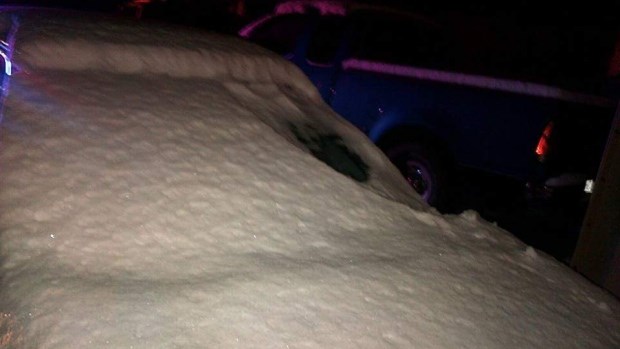There's nasty weather in store for this afternoon and, if Monday evening's commute is any indication, there could be some tricky spots in store for motorists.
We called on the Coquitlam RCMP's resident driving expert, Cpl. Quentin Frewing of the traffic section, for a bit of Snow Driving 101.
The most common mistakes?
"People drive in winter conditions as if it's summer," Frewing said . "They're accelerating at the same speeds, braking at the same speed, making sharp turns — it's all very dangerous when the roads are icy and slippery."
Clearing a small patch of the windshield before heading off to work? A big no no, Frewing said.
The entire vehicle needs to be cleared off, including the windshield, licence plate, lights, roof, all side windows and the rear window. Fines for failing to do so range from $109 (if lights are covered by snow or dirt) to $167 (if you're not driving appropriately for the road and weather conditions) and $230 (obstructed licence plate).
And that high-pitched spinning sound? Be prepared to go nowhere.
"I'm seeing a lot of summer tires spinning in the snow," Frewing said. All that friction is creating your own personal patch of ice, not to mention wrecking your summer wheels — so get the proper winter gear instead.
BEFORE YOU GO
Are you comfortable driving in the snow? Be honest, Frewing says, and if you're not, use transit instead.
Is your vehicle ready for the snow? More than anything, having the right tires is by far the most important safety measure for winter driving — and new all-seasons don't necessarily cut it.
"All-seasons is a misnomer, it's misleading," Frewing said. "At 7C and under, even if there is no snow on the roads, because of the temperature of the pavement the ability of the rubber compound in all-season tires to grip is decreased. You need a softer rubber compound to get a better grip to be safely on the road."
Snow tires are the best, but some all-season tires are rated for winter weather as well.
Check the side wall of your tire and look for one of two symbols: M + S means your tires are suitable for mud and snow, while the alpine symbol (a three-tiered mountain with a snowflake) means it's a dedicated snow tire.
If you don't see those symbols, don't drive in the snow.
"You should have tires appropriate for the road," Frewing repeated (several times).
HOW TOs
Frewing's main piece of advice is to keep it slow and steady.
"The operative word is smooth: Acceleration, deceleration and braking, smooth turning."
So when that red light turns green, ease into the gas (don't gun it), and give yourself plenty of stopping distance before the car in front of you (at least a four-second gap).
Do you see a hill rising in your near future? Don't panic, and maintain your momentum to ensure you get to the top.
"You don't want to floor it, but you don't want to go too slow either," Frewing said. "It takes a bit of experience and practice."
Same goes for driving downhill, when you can shift into a lower gear to slow down (but keep in mind your braking ability will be reduced).
Frewing also cautioned drivers who have ABS brakes to not let the "chattering" sound scare them — it's just the brakes squeezing and releasing on the disc rotors at a fast rate to keep the vehicle from skidding.
"A lot of people's first reaction is to take their foot off the brake, but that's the last thing you should do," he said. "You should push down on the brake and help the vehicle to stop more safely."
WHAT NOT TO DO
Even the most prepared drivers can encounter the unexpected, Frewing said, but there are ways to get through it.
If you do hit black ice (it has less air bubbles so it's harder to see, and it usually forms during the morning and evening commutes), stay calm, do your best to decelerate the vehicle gently and ride it out until the vehicle is gripping the road again.
Keep your eyes focused on where you want to go and steer in that direction — again, gently.
"If you're going through a patch of ice the last thing you want to do is steer frantically," Frewing said. "If you're already pointing in a safe direction, keep steering that way and slowly decelerate."
Long story short?
"You should have tires that are appropriate for the road conditions," Frewing said. "And the number one thing is to give yourself more time and more distance from the car ahead of you. And keep it smooth, smooth smooth."
• For more info and tips on winter driving, visit www.icbc.com.
spayne@tricitynews.com
@spayneTC



